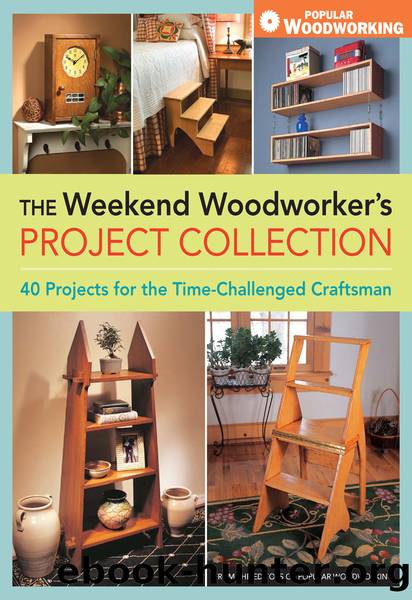The Weekend Woodworker's Project Collection by Popular Woodworking

Author:Popular Woodworking
Language: eng
Format: epub
Tags: epub, ebook
Publisher: Penguin Publishing Group
Published: 2010-06-15T00:00:00+00:00
Chippendale Mirror
BY KERRY PIERCE
ALTHOUGH NOT A REPRODUCTION OF ANY SPECIFIC EIGHTEENTHCENTURY ORIGINAL, THIS MIRROR DOES EVOKE A NUMBER OF CHIPPENDALE DESIGNS.
Shaper cutters and router bits come in a bewildering array of shapes and sizes and the exact configuration required for a particular project isn't always available. But often, through some imaginative blending of manufactured shapes (sometimes mixed with a little handwork), the woodworker can create the necessary forms.
This photo shows how the scrollwork, tack strip and cleat are assembled.
The moulding that frames the glass on this Chippendale mirror was produced through the use of two three-winged shaper cutters and a little rabbet work on the table saw. Although not a reproduction of any specific eighteenth-century original, this mirror does evoke a number of Chippendale designs.
Begin construction with the scroll-work background. After the pieces have been band sawn and sanded, assemble them with butt joints and hold in place wit a pair of cleats which are glued and screwed across the back of the scrollwork. At that time, take measurements for the large moulding that lifts and presents the glass.
Working with these measurements and the available shaper cutter and router bits, you can determine the moulding's profile. After the stock had been run, miter the four pieces of the moulded frame to length and screw into place. Complete finishing before installing the mirror to avoid sullying its surface. Tack four wood strips to the back, inside face of the moulding to hold it in place.
This makes stylistic attribution a slippery business. Even though almost all high-style American furniture of the late eighteenth and early nineteenth centuries exhibits characteristics of Chippendale, Hepplewhite and Sheraton designs, very little actually represents any specific published drawings. Further complicating the business of stylistic attribution is the fact that many pieces exhibit characteristics of more than one style. A sideboard might have a spade foot (a Hepplewhite signature) and a gallery of turned spindles (associated with Sheraton's designs).
A chair might have a balloon back and solid splat (Queen Anne) and ball-and-claw feet
(Chippendale). In the hands of a skilled craftsman, such blending is unimportant. A well-designed chair is a well-designed chair whatever the origins of its iconography.
But for the student of furniture, it can be useful to look at this matter of stylistic attribution-not to fasten a particular label on a particular piece but in order to reflect on the American designer/crafts-man's handling of the forms and motifs with which he worked.
What Are the Characteristics of Chippendale Furniture?
In the strictest sense, the only furniture that can be identified as Chippendale is that to which Thomas Chippendale, the English carver and designer actually applied his tools. But there are few such pieces and many that are commonly (and usefully) referred to as Chippendale.
Another approach reserves the Chippendale name for those pieces that are exact representations of his published drawings. But this, too, is very limiting, particularly when discussing furniture made in North America. While there are a handful of American-made pieces which accurately represent specific Chippendale designs, the over-whelming majority of American-made Chippendale furniture does not â for some very good reasons.
Download
This site does not store any files on its server. We only index and link to content provided by other sites. Please contact the content providers to delete copyright contents if any and email us, we'll remove relevant links or contents immediately.
The Body: A Guide for Occupants by Bill Bryson(5027)
Audition by Ryu Murakami(4887)
Adulting by Kelly Williams Brown(4530)
Housekeeping by Marilynne Robinson(4391)
1578 Plant Pattern Recognition Receptors by Unknown(4326)
Be in a Treehouse by Pete Nelson(3996)
Zero Waste Home by Bea Johnson(3804)
Seriously... I'm Kidding by Ellen DeGeneres(3606)
Better Homes and Gardens New Cookbook by Better Homes & Gardens(3547)
The Healing Self by Deepak Chopra(3523)
Barkskins by Annie Proulx(3334)
Hedgerow by John Wright(3316)
The Cellar by Natasha Preston(3296)
Spark Joy by Marie Kondo(3270)
The Genius of Japanese Carpentry by Azby Brown(3254)
The Life-Changing Magic Of Tidying Up- The Japanese Art Of Decluttering And Organizing (v5.0) by Marie Kondo(3233)
120 Days of Sodom by Marquis de Sade(3223)
Work Clean by Dan Charnas(3078)
The Book of Numbers by Peter Bentley(2928)
